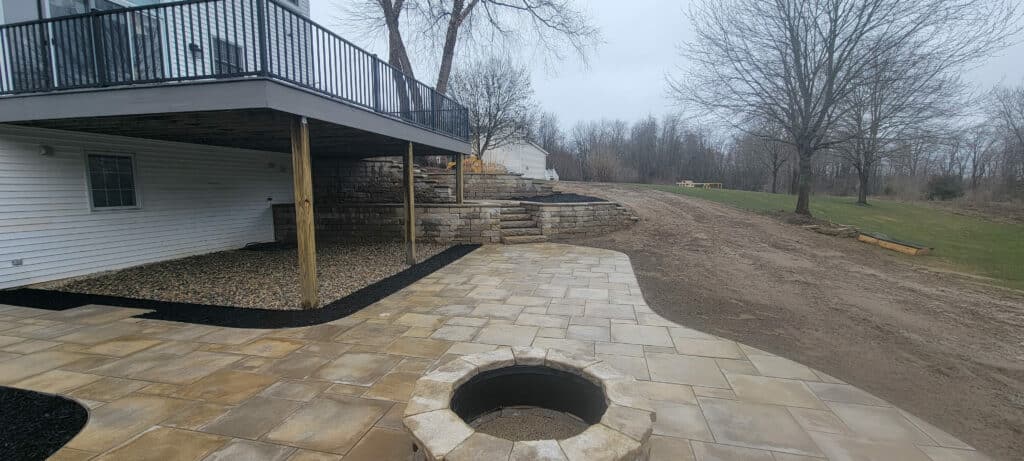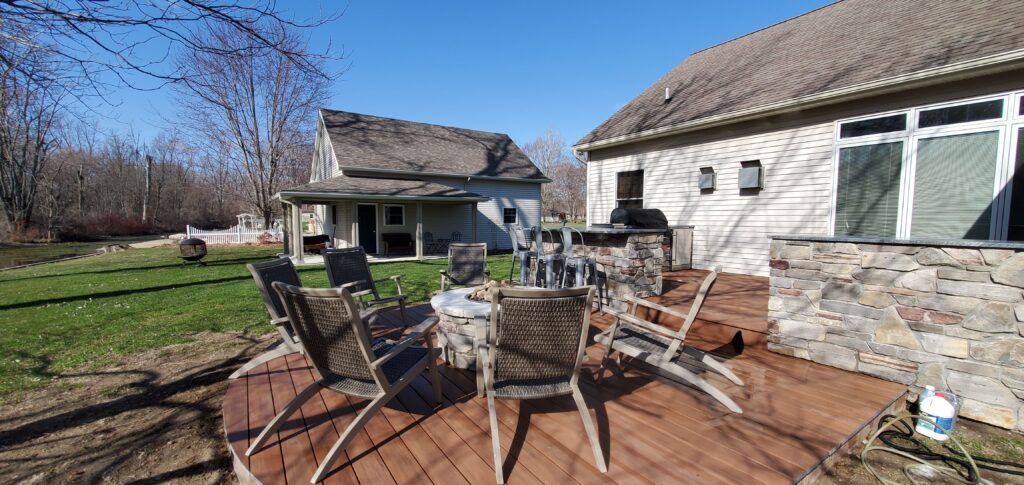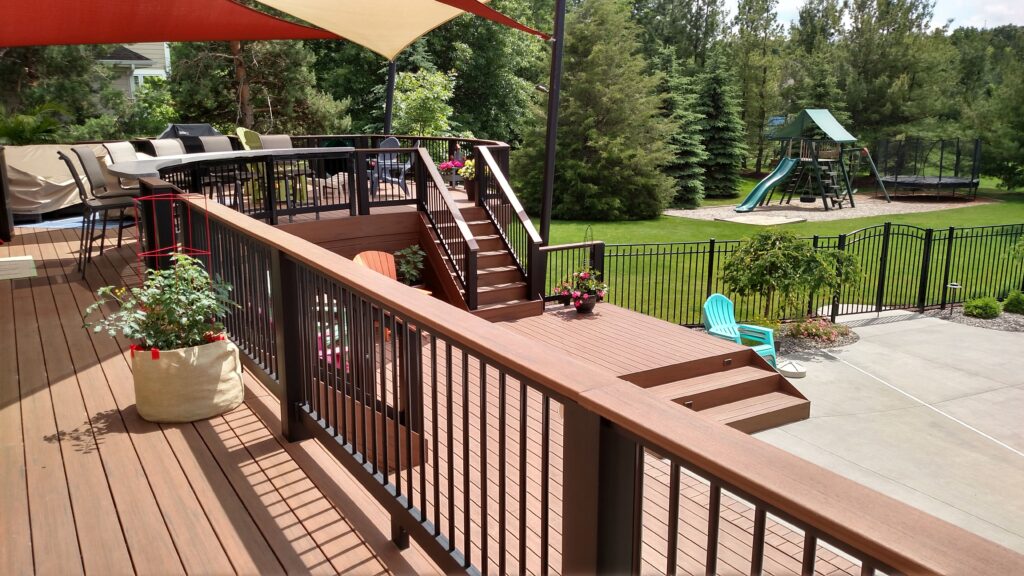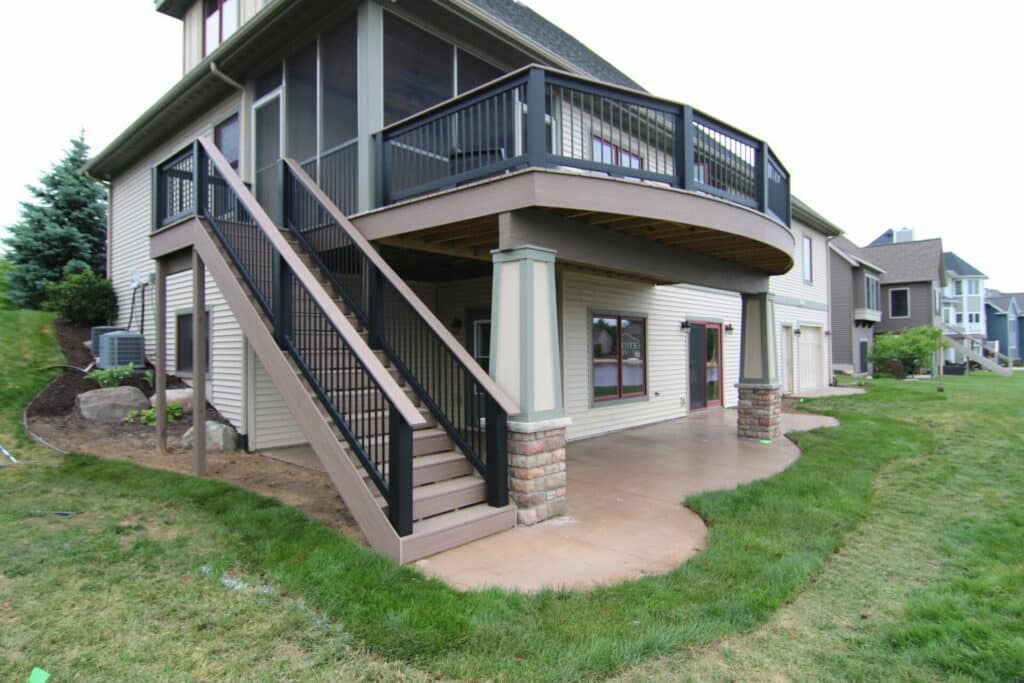Concrete Patios vs Wood & Composite Deck Installation
When contemplating adding a concrete patio, wood deck, or composite deck to your home, you want to make the right choice. This will improve the look of your home and its functionality so you can fully enjoy your outdoor space.
This decision is more than just picking a material; it’s about shaping the backdrop for your future outdoor gatherings, quiet mornings, and family activities.
Your choice will be influenced by practical factors such as your local climate, the lay of your land, your budget, and how much time you will devote to upkeep. Plus, it’s essential to consider how your choice aligns with your home’s overall style, the potential impact on its value, and your budget.

Looking at the Differences Between a Patio and a Deck
A patio is typically a paved area situated directly on the ground, which can either be attached to the house or located separately in a garden. It’s usually made from concrete, pavers, stone, tile, brick, pebbles, or gravel. Patios are best suited for flat terrain but can be adjusted to fit slightly sloped ground with the right foundation.
Custom decks are generally elevated structures made of wood, composite deck boards, or PVC decking. They are primarily attached to the home and raised from the ground, supported by posts or beams, providing a view of the surroundings. Decks are suitable for any terrain, especially uneven or sloping landscapes, as they can be built to various heights.
If your yard is sloped, then a deck will serve you better.
Comparing Materials used for Concrete Patios, Wood Decks, and Composite Decks

Concrete Patios
Concrete is highly durable and can last for decades with proper maintenance.
Concrete patios require occasional cleaning and sealing to prevent cracks or surface damage. It can also be stamped, stained, or textured to enhance aesthetic appeal. However, concrete tends to absorb and retain heat, which can be uncomfortable in the heat.
Wood Decks
Wood offers a natural, warm appearance that many find appealing. For wood decking, you can choose from pressure-treated wood or natural wood, like cedar or ipe. If you like the beauty of wood, this is a good choice. However, regular maintenance will require staining, sealing, and checking for splinters and surface damage.
As for durability, actual wood is susceptible to weathering, rot, and insect damage, especially if not well-maintained. Wood generally stays cooler than concrete in direct sunlight.
Composite Decks
Composite decking materials are eco-friendly because they are made of recycled wood fibers and plastic. Composite boards come in various colors and textures, some mimicking the look of wood grains.
Composite decking products are durable because they resist rot, decay, and insect damage. They are generally more durable than wood. Composite material for decks has become very popular among homeowners because they require minimal maintenance, with no need for sanding, staining, or sealing.
When evaluating the cost compared to wood, composite decks are initially more expensive, but savings on maintenance can offset the initial cost over time.
Concrete Patio, Wood Deck, and Composite Deck Installation Considerations

- Concrete Patios: These patio projects are typically easier and quicker to install than decks. They require a properly prepared subbase and might need rebar or wire mesh for additional strength. They can be installed on uneven terrain, but only after proper grading.
- Wood and Composite Decks: These require more complex installations, often requiring a framework and footings. They can be constructed over uneven or sloping land more easily than concrete. Composite decks require similar installation techniques to wood but with specific deck fasteners and spacing requirements. With a deck, you can cover it and turn it into a covered porch.
So, Which is Best for You?
As you contemplate which outdoor project is best for you, your family, and your home, we have some factors for you to consider before making a decision:
- Consider the cost: Initial costs for wood decks can be lower than composite, but composite decks often offer savings over time due to lower maintenance costs. Concrete patios generally have the lowest initial cost but might not add the same aesthetic or value as decks.
- How space will be used: Consider the activities you envision; dining, lounging, or entertaining can influence the choice. Decks, especially elevated ones, are great for views, while patios are ideal for a seamless indoor-outdoor feel.
- Weather can be a factor: Weather conditions play a significant role. Wood can deteriorate faster in harsh climates, while concrete can crack in freeze-thaw conditions. Composite materials typically withstand a wide range of weather conditions.
Why a Composite Deck Installation Might Be the Best Choice
A composite deck is often considered the best choice for several reasons:
- Durability: Composite decking is designed to resist fading, staining, scratching, and mold, maintaining its appearance for years without sanding, staining, or painting.
- Low Maintenance: Unlike wood, composite decking doesn’t require regular maintenance such as staining, sealing, or painting, saving time and money over the deck’s lifespan.
- Aesthetics: It offers a variety of colors, textures, and styles, some of which closely mimic the natural beauty of wood without the associated maintenance challenges.
- Long-Term Cost-Effectiveness: Although the initial cost is higher, minimal upkeep and longer lifespan can make composite decking more cost-effective.
- Eco-Friendly: Many composite decks are made from recycled materials, which helps reduce waste and can be more sustainable than traditional wood decking.
While composite decking can be the superior choice considering longevity, maintenance, and aesthetics, the homeowner’s specific situation, preferences, and local conditions should always guide the final decision. However, if you are building an elevated deck, why not both?
Get Started on Your Project
We understand that your outdoor project isn’t just an addition to your property but a new way for you and your family to enjoy your home. Let us craft your deck or patio with the care, attention to detail, and precision it deserves. Be sure to check out our outdoor living projects for ideas on improving your home.


